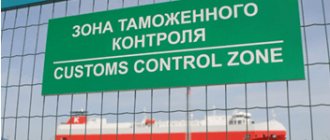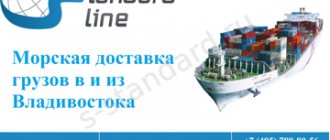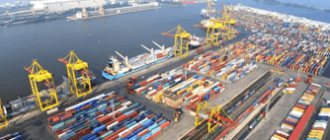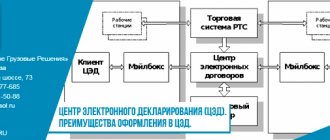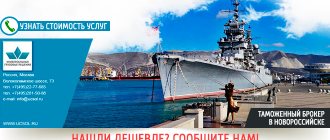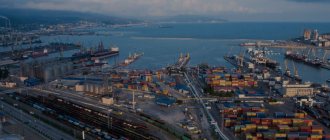NOVOROSSIYSK CUSTOMS Operating company (78 years on the market)
OGRN 1032309080264 INN 2315060310 / KPP 231501001
Registration date
December 6, 1943
Main activity
Activities of state administration bodies and local self-government on general issues
Legal address
353915, Krasnodar region, Novorossiysk, Myskhakskoe highway, 61
On the map
Organizational and legal form
Federal government agencies
Head of Novorossiysk customs
Lushnikov Yuri Vladimirovich INN 526015226880
Unified Register of Small and Medium Enterprises
Not included in the registry
Express analysis
100%
The company's rating is very high
+2517 points for positive factors
-25 points for negative factors
Positive factors
- Long working time
The company was registered 78 years ago, which indicates stable activity and supervision by government agencies.
- Licenses available
The company has received several licenses, which is a sign of the high reliability of the counterparty.
- Participant in the public procurement system
The company is an official participant in the public procurement system under 44-FZ.
- Contracts as a customer
Signed several contracts under 94-FZ, 44-FZ or 223-FZ as a customer.
- Not included in the register of unscrupulous suppliers
According to the FAS, it is not included in the register of unscrupulous suppliers.
- No connections to disqualified persons
According to the Federal Tax Service, the company’s executive bodies do not include disqualified persons.
- There are no mass leaders and founders
The leaders and founders of NOVOROSSIYSKAYA CUSTOMS are not included in the registers of mass leaders and mass founders of the Federal Tax Service.
Negative factors
- Debts in enforcement proceedings
According to the FSSP, there are debts from enforcement proceedings. Balance of outstanding debt: RUB 58,727. Information current as of December 14, 2021. There may be similarities in name and address, double-check the information on the official website of the FSPP.
Requisites
| OGRN | 1032309080264 |
| TIN | 2315060310 |
| checkpoint | 231501001 |
| Code KLADR | 230000060000227 |
| OPF code | 75104 (Federal government agencies) |
| OKTMO code | 03720000 |
| SDR code | 03181000067 |
| ICU | 12315060310231501001 |
See also information about registration of NOVOROSSIYSK CUSTOMS with the Federal Tax Service, Pension Fund of Russia and the Federal Insurance Fund
Novorossiysk customs
Novorossiysk customs
Customs authority code: 10317000 Address: 353900, Krasnodar region, Novorossiysk, Myshakskoe highway st. 61 Telephone Reception, 61-32-85, Telephone Duty
Novorossiysk customs office, Myshakskoe highway st. 61.
-Head of Customs: Rovchak Andrey Valerievich. Tel. -First Deputy Head of Customs: Kondratyev Igor Eduardovich Tel., 61-32-64 -Deputy Head of Customs: Mikhailov Dmitry Valentinovich Tel., 75-92-61 -Deputy Head of Customs (for economic activities): Trifonov Alexander Valentinovich Tel., 75 -92-25 -Deputy Head of Customs for Law Enforcement: Onipko Valery Evgenievich Tel. -Head of the OAR department: Piyakin Denis Sergeevich Tel. -HR department, legal department, ODO, accounting, etc. Tel. reception, 61-32-85, 75-92-18 Tel. duty +.
Legal Department - Head of Department: Danilenko Evgeniy Vladimirovich - Deputy Heads: Evseeva Tatyana Anatolyevna, Dudorova Olga Vladimirovna Tel., 60-44-17, 60-26-77, 60-44-17.
Documentation support department - Head: Natalia Borisovna Artyushchenko Tel., 60-47-14, 75-92-18.
Customs transit control department - Head: Alekseenko Alexander Nikolaevich Tel..
Customs value control department - Head: Kocheganov Denis Viktorovich Tel..
Customs Payments Department - Head: Vinogradova Irina Stanislavovna Tel., 75-92-48, 75-92-49.
Administrative Investigation Department Tel..
Novorossiysk Western Customs Post, st. Portovaya, 6.
-Chief: Khabarov Alexander Viktorovich -Deputy. Head: Fedosov Oleg Aleksandrovich - Head of Maintenance and Technical Control: Andreev Andrey Stanislavovich Tel.,.
Novorossiysk central customs post, st. Portovaya, 22.
-Customs post “Sea Port of Novorossiysk” (VTT, transit, orders for loading). -Head: Kovalenko Alexander Fedorovich -Deputy Head: Novikov Alexey Nikolaevich -Head of H&T: Shtifanov Vladimir Vladimirovich Tel. +, 60-26-39. Tel. reception.
Novorossiysk south-eastern customs post, street, Sukhumiyskoe highway, 17.
- VTT registration department. -Chief: Burdaev Vladislav Nikolaevich. -Head of H&T: Likhovitsky Evgeniy Valentinovich Tel., 67-67-78 Tel. reception
Novorossiysk customs, st. Magistralnaya, 2.
-Deputy Head of Customs (for law enforcement): Dmitry Ivanovich Bilanov Tel., -OAR, ORO, OBOVK, OBKN. Tel. +7 8617 602831, 604417, 604746.
Gelendzhik customs post, Gelendzhik, L. Schmidt St., 10.
-Chief: Misyura Dmitry Viktorovich. -Head of the design department: Protsenko Igor Anatolyevich. Tel. +7 86141 3-28-72.
Anapa customs post, Anapa, Anapa Airport.
-Chief: Slesarenko Sergey Ivanovich. -Head of the design department: Volotko Elena Nikolaevna. Tel. +7 86133 9-87-01, 9-84-21.
Contacts
| Address | 353915, Krasnodar region, Novorossiysk, Myskhakskoe highway, 61 On the map |
| Phones | +7,, +7 (76177) 5-92-97 |
| Fax | +7 |
| [email protected] | |
| Web site | yutu.customs.ru |
| Is your contact information out of date? If you are related to NOVOROSSIYSKY CUSTOMS and know the exact contact details of this company, please share them. Edit contacts | |
Address: 353919 Krasnodar region, Novorossiysk Myskhakskoe highway, no. 61
Documentation support department head of department
Legal department, (8617) 22-00-57
Information for written appeal from citizens 353919 Krasnodar Territory, Novorossiysk Myskhakskoye Highway, 61 Inquiries on incoming documents: t/fax (8-8617)-22-10-06, 791-218
Information for oral appeal of citizens Telephone of the documentation department of the Novorossiysk customs: (8-8617) - 220-064, tel./fax (8-8617) - 22-10-06 Telephone reception of the Novorossiysk customs (8-8617) 22-00-83 , 791-228, fax. (8-8617) 791-283 Helpline of Novorossiysk customs (8-8617)-791-200
JOB TITLE
| CITY code No. Novorossiysk (8617) | ADDRESS | |
| Head of Customs | 61-32-85 | 353919 Krasnodar region, Novorossiysk Myskhakskoe highway, no. 61 |
| Reception | 79-12-28 61-32-85 tel./fax | |
| First Deputy Chief | 79-12-22 61-32-64 | 353919 Krasnodar region, Novorossiysk Myskhakskoe highway, no. 61 |
| Deputy Head of Customs (for economic activities) | 22-39-03 79-12-25 | 353919 Krasnodar region, Novorossiysk, Myskhakskoe highway, 61 |
| Deputy Head of Customs for Law Enforcement | 79-12-24 64-66-82 | 353919 Krasnodar region, Novorossiysk, Myskhakskoe highway, 61 |
| Deputy Head of Customs | 22-39-00 79-12-61 | 353919 Krasnodar region, Novorossiysk, Myskhakskoe highway, 61 |
| Deputy Head of Customs (HR) | 79-12-26 61-32-56 | 353919 Krasnodar region, Novorossiysk Myskhakskoe highway, no. 61 |
| Novorossiysk motor transport customs postHead of customs post | 79-12-67 22-39-09 | 353960, Novorossiysk, p. Tsemdolina, st. 5-ya Promyshlennaya, 3-a |
| Novorossiysk Western Customs PostHead of Customs Post | 64-37-99 | ind. 353901, Krasnodar region, Novorossiysk, st. Portovaya, 6 |
| Novorossiysk central customs post Head of the customs post reception | 60-26-39 60-26-39 tel./fax | ind. 353901, Krasnodar region, Novorossiysk, st. Portovaya, 22 |
| Novorossiysk south-eastern customs post Head of the customs post Reception room | 67-67-76 67-67-78 tel./fax | ind. 353902, Krasnodar region, Novorossiysk, Sukhumskoe highway, 17 A |
| Gelendzhik customs post Head of Gelendzhik customs post. | (86141) 3-28-72 | ind. 353460, Krasnodar region, Gelendzhik, st. Shmidta, 10 – corner of the street. Pushkina 42v |
| Anapa customs post Head of the post Duty officer 24 hours a day | (86133) 9-87-01 9-84-21 tel/fax | 353447, Krasnodar region, Anapa-7, Anapa Airport |
| Legal DepartmentHead of DepartmentDeputy Head | (8617) 79-12-40 60-44-17 22-00-57 tel./fax | 353919, Krasnodar region, Novorossiysk, Myshakskoe highway, no. 61 |
| Documentation support department Head Deputy head of ODO | 79-12-77 60-47-14 79-12-18 tel./fax | 353919, Krasnodar region, Novorossiysk, Myshakskoe highway, no. 61 |
Types of economic activities
Main activity
| 84.11 | Activities of state administration bodies and local self-government on general issues |
Licenses
1. License No. AN 23-000858 dated May 22, 2019
Kind of activity
Activities for transporting passengers and other persons by buses
Licensing authority
Novorossiysk Department of Motor Transport and Road Supervision
2. License No. FS-23-01-004697 dated December 23, 2016
Kind of activity
Medical activities (with the exception of the specified activities carried out by medical organizations and other organizations included in the private healthcare system in the territory of the innovative)
Licensing authority
Territorial body of Roszdravnadzor for the Krasnodar Territory
3. License No. 77.99.15.002.L.000218.08.07 dated August 13, 2007
Kind of activity
Activities in the field of use of ionizing radiation sources (generating) (except for the case if these sources are used in medical activities)
Licensing authority
Federal Service for Supervision of Consumer Rights Protection and Human Welfare
Contacts and details
| Name | Novorossiysk customs |
| Customs code | 10317000 |
| Organizational structural form | Customs authority (not specialized) |
| Customs clearance | not produced |
| Parent's name | Southern Customs Department |
| Short name | Novorossiysk customs |
| Kind of transport | Sea, River |
| OKPO | 1860880 |
| OGRN | 1032309080264 |
| TIN | 2315060310 |
| checkpoint | 231501001 |
| Full address | 353919, Krasnodar region, Novorossiysk, Myskhakskoe highway, no. 61 |
| Telephone | +7, |
| Fax | +7 |
| [email protected] | |
| Website | https://yutu.customs.ru/folder/12058 |
| Working with ATA carnets | Yes |
| OKATO code | 3000 |
| SOATO code | 1103 |
Novorossiysk customs on the map
Other posts and customs of Novorossiysk and Krasnodar Territory
- Customs post Sochi Airport (10318010)
- Customs post MAPP Adler (10318020)
- Customs post of railway border crossing point Adler (10318050)
- Sochi central customs post (10318060)
- Anapa customs post (10317010)
- Gelendzhik customs post (10317020)
- Primorsky customs post (10317080)
- Novorossiysk Western Customs Post (10317090)
- Novorossiysk central customs post (10317100)
- Novorossiysk south-eastern customs post (10317110)
- Novorossiysk customs post (electronic declaration center) (10317120)
- Sochi customs (10318000)
- Krasnodar customs (10309000)
- Yeisk Customs Post (10309030)
- Crimean Customs Post (10309090)
- Customs post Krasnodar Airport (10309130)
- Customs post Seaport Kavkaz (10309140)
- Customs post Seaport Temryuk (10309150)
- Tuapse Customs post (10309180)
- Prikubansky Customs post (10309200)
Subordinate organizations
- Anapa customs post (10317010)
- Gelendzhik customs post (10317020)
- Primorsky customs post (10317080)
- Novorossiysk Western Customs Post (10317090)
- Novorossiysk central customs post (10317100)
- Novorossiysk south-eastern customs post (10317110)
- Novorossiysk customs post (electronic declaration center) (10317120)
See also: Krasnodar region, Novorossiysk, Customs, Seaports
Background information about Novorossiysk EDC
| Full name | Novorossiysk customs post - electronic declaration center |
| Short title | Novorossiysk Center for Electronic Declaration (CED) |
| Customs post code | 10317120 |
| Status | valid from 09/20/2018 |
| Unit type | without specialization |
| Customs clearance | carried out |
| Working with ATA carnets | No |
| Address | Russian Federation, 353919, Krasnodar region, Novorossiysk, st. Myshakskoe highway, 61 |
| [email protected] [email protected] | |
| Phones | +7(861)779-14-44, – department of documentation circulation +7(861)779-14-46 +7(861)779-14-47 – department of customs clearance and customs control +7(861)779-14 -48 |
| Official site | Go to website >>> |
| OKATO code | 03420 |
| SOATO code | 1103 (Krasnodar region) |
| Operating mode | from 9:00 to 21:00 - daily |
Temporary storage warehouses located in the area of activity of the Novorossiysk Central Economic Distribution Center (Novorossiysk)
| temporary storage warehouse | ADDRESS | ||||
| Volgograd industrial packaging plant | Volgograd region, Volgograd | InformationRoad transport, With the exception of vehicles indicated under codes 31, 32 | – | – | – |
| Crimean customs terminal | Krasnodar region, Krymsky district, village. Pearl | InformationRoad transport, With the exception of vehicles indicated under codes 31, 32 | – | – | – |
| MegaTek | Krasnodar region, Krasnodar | InformationRoad transport, With the exception of vehicles indicated under codes 31, 32 | – | – | – |
| Commonwealth Plus | Rostov region, Azov | InformationRoad transport, With the exception of vehicles indicated under codes 31, 32 | – | – | – |
Customs broker services
- Personal customs clearance specialist;
- We prepare and execute the necessary documentation - declarations, applications, various permitting forms, documents, reporting;
- Recommendations on HS codes for goods;
- Preliminary calculation of customs value and amount of advance customs payments;
- Drawing up DT projects and related documents;
- Document flow with customs;
- Submission of information at the request of Novorossiysk customs;
- Representation of the Customer's interests in the customs authorities of the Russian Federation;
- Organization, if necessary, of preliminary customs inspection of goods and vehicles before submitting the DT;
- Drawing up a declaration of intent under the seal of the customs representative;
- Consulting in the field of foreign economic activity (FEA);
Customs clearance services for goods at the Novorossiysk CED
Our company “Universal Cargo Solutions” carries out customs clearance in the Novorossiysk CED of any cargo and goods in various customs procedures: import (release for domestic consumption), export, customs transit, temporary import, temporary export and others. We provide the services of a customs broker - customs representative and carry out “customs clearance” when importing, or “customs clearance” when exporting in the Novorossiysk CED. We work with legal entities and individual entrepreneurs. We help prepare a package of documents for customs, calculate the customs duties required for payment, fill out customs declarations and promptly release goods at the electronic declaration center of the Krasnodar customs. If necessary, we carry out customs clearance in other EDCs of the country.
We provide services to foreign trade participants:
- Legal entities
- For individual entrepreneurs
Do you need to register goods at the Novorossiysk Central Export Center? - We will help you!
Documents and information for customs clearance at the Novorossiysk CED
- List of documents for registration of a Legal entity at customs (View)
- List of documents for registration of an individual entrepreneur at customs (View)
- List of documents for customs clearance “Import” (View)
- List of documents for customs clearance “Export” (View)
- Sample payment order to ELS customs (View)
Novorossiysk EDC
Novorossiysk EDC - contact information
Novorossiysk EDC is the electronic declaration center of Novorossiysk customs.
The customs post was created on September 20, 2018 to replace the now abolished Krasnodar Central Customs Office (10309190) of the Krasnodar customs. The Novorossiysk EDC is subordinate to the Novorossiysk customs, and uses the latest technologies for remote electronic declaration, which allows it to carry out customs clearance - “customs clearance” for imports, “customs clearance” for the export of any goods, and for foreign trade participants to register here goods located in the area of activity of any territorial division of the Southern Customs Administration (UTU) of the Federal Customs Service of the Russian Federation. The location of the Novorossiysk customs center is Krasnodar region, Novorossiysk, Myshakskoe highway, 61. This is the industrial center of the city. Nearby are the Novorossiysk port, the Novorossiysk railway station (North Caucasus Railway), and the federal highways M 4 Don (Moscow), A-290 (Kerch).
- Head of the customs post: Syanov Ivan Yurievich
- Reception: Piskun Tatyana Nikolaevna
- Address: 353919 Krasnodar region, Novorossiysk Myskhakskoe highway, 61
- Phone 79-14-44 79-14-45
Customs posts located in the area of activity of the Novorossiysk CED
- Anapa customs post (code 10317010) of Novorossiysk customs
- Gelendzhik customs post (code 10317020) of Novorossiysk customs
- Novorossiysk western customs post (code 10317090) of Novorossiysk customs
- Novorossiysk central customs post (code 10317100) of Novorossiysk customs
- Novorossiysk south-eastern customs post (code 10317110) of Novorossiysk customs
- Primorsky customs post (code 10317080) of Novorossiysk customs (in relation to goods transported by water transport)
- Yeisk customs post (code 10309030) of Krasnodar customs (in relation to goods transported by water transport)
- customs post Seaport Kavkaz (code 10309140) of Krasnodar customs
- customs post Seaport Temryuk (code 10309150) Krasnodar customs
- Sochi central customs post (code 10318060) of Sochi customs
- OTOiTK No. 2 of the Sochi central customs post (code 10318062) of Sochi customs
- customs post Seaport of Taganrog (code 10319070) Taganrog customs
- Evpatoria customs post (code 10321020) of the Crimean customs
- Kerch customs post (code 10321030) of the Crimean customs
- OTOiTK No. 2 of the Kerch customs post (code 10321031) of the Crimean customs
- Feodosia customs post (code 10321070) of the Crimean customs
- Yalta customs post (code 10321080) of the Crimean customs
- Inkerman customs post (code 10322010) of Sevastopol customs
- customs post Kamyshovaya Bay (code 10322020) of Sevastopol customs
- OTOiTK No. 2 customs post Kamyshovaya Bay (code 10322021) Sevastopol customs
Advantages of the EDC of Novorossiysk customs
- The area of responsibility of the Novorossiysk customs center covers the entire Southern Federal District of the Russian Federation;
- Open daily, seven days a week;
- Customs clearance of any cargo and goods is carried out: food, as well as other perishable goods (meat, meat products, milk, dairy products, fish, seafood, vegetables, fruits); industrial goods (clothing, shoes, consumer electronics, machines, equipment, lumber and any others.
- Customs clearance of goods delivered by any means of transport is carried out: road; air; railway; sea
History of Novorossiysk customs
In the lives of each of us, special dates come from time to time. Such, for example, as a birthday or anniversary. This is the event that Novorossiysk Customs is celebrating this year - 167 years since its founding. The history of customs service in the Russian Empire began in the 17th century. The first customs charter was issued in 1653 by decree of Tsar Alexei Mikhailovich. Following this, 14 years later, a new trading charter was issued. It said: “Foreign goods entering the markets must have marks, seals and all reasonable signs indicating where they were produced.” State customs officials were given the task of preventing the import of low-grade products, “so that from now on bad goods on holiday to the Moscow state would be taught under a cruel commandment and they would stop sending them, and bad goods, having been exposed and announced to the whole world, would be sent out with dishonor, fairs so that in future such they did not import bad goods and did not spoil the prices of good goods.” At the same time, they began to take a duty on the valuation of goods, hidden trade items were confiscated for the benefit of the treasury, and clerks “were beaten mercilessly with the whip for concealing the master’s goods.” Novorossiysk customs traces its history almost from the founding of the city. Well, trade in various goods was carried out on these lands long before that. Even in ancient times, local tribes exchanged weapons, household items and jewelry with newcomers. Trade retained this barter character until the 19th century. At that time, the Black Sea coast was inhabited by Circassians, Shapsugs, Nagais and other warlike mountain peoples. Goods were brought here from all over the world. Archaeological finds confirm this. Italian brocade, Chinese dishes and mirrors... and much, much more. Trade relations with Turkey were built in a special way. The most valuable and desirable commodity for the Turks were slaves. Over the years, how many young girls have been forcibly taken from these shores, separated from their families and loved ones? What was it like for the free beauties born on the shores of Kalolimena - the “Beautiful Harbor”, in the harems of the sultans? Now we can only guess about this. By the way, one of the proofs of the then flourishing slave trade has survived to this day. The name of the city of Gelendzhik translates as “white bride”... Trade in these lands took on a different form from the moment the Russians appeared here. In 1829, after the end of the Russian-Turkish War, according to the Adrian Peace Agreement, a narrow strip of the eastern coast of the Caucasus from the mouth of the Kuban River to the Georgian border went to Russia. For a more durable establishment in the newly conquered territories, the Black Sea coastline was built here, consisting of a number of fortifications. The mountaineers did not stop fighting for their lands, and over time they found how to benefit from such a not very happy neighborhood for them. The Russian military willingly exchanged food and other goods from the indigenous residents. Trade was strictly controlled. Some goods were allowed through the border gates on payment of duties, while others were not allowed to be imported at all. To protect the region from the introduction of infectious diseases across the border, quarantines were established. General Nikolai Raevsky, one of the founders of Novorossiysk, played a major role in establishing friendly relations with the mountaineers. He was the first to propose creating customs houses at the fortifications, holding bazaars, selling the goods they needed to the mountaineers at prices lower than Turkish prices - salt, iron products, in general, everything except weapons. His work was continued by Admiral Serebryakov. Thanks to Lazar Markovich, during the fortification of Novorossiysk, a civilian settlement appeared, which marked the beginning of the emergence of a city here. On June 30, 1845, Sovereign Emperor Nicholas I deigned to command: until the final resolution of general assumptions on the structure of trade, customs and quarantines on the Eastern Shore of the Black Sea, the following orders should be made as a temporary measure. 1. Open a port in Novorossiysk to receive Russian and foreign ships coming from abroad, establishing a customs outpost in Novorossiysk, with 2,325 rubles allocated to it at the expense of the State Treasury. 2. Allow the same goods to be brought to the Novorossiysk port as are allowed to be brought to Sukhum - Kale according to the article of the code of the Customs Charter and according to the Highest approved list of goods. 3. Set a monthly deadline for clearing duty on foreign goods in Novorossiysk. The quarantine and customs outpost opened its operations in January 1846. The first manager in its history was court councilor Ignatiy Anatolyevich Lontkevich. Novorossiysk customs received ships, collected duties and fought against smuggling, the main object of which was still slaves. In exchange for slaves, the highlanders received Turkish weapons, gunpowder and shells. By the way, the Circassian women rescued by Russian soldiers, having avoided the fate of being slaves in Turkish harems, had the opportunity to independently arrange their own fate. By the highest decree they were allowed to marry the lower ranks of the Russian army. At that time there were no piers here. The ships entered the bay and moored at dead anchors with barrels. Overseas fabrics, varnishes, threads, Turkish tobacco in bales, melons, watermelons, Georgian wine and alcohol are transported on longboats and feluccas to the shore. In the shopping area (now this place is Heroes Square) there was a brisk buying and selling going on. But before reaching the market, the goods were subject to customs inspection and duty clearance. The building of the quarantine and customs outpost was located here on the embankment, approximately in the place where the house under the spire is now located. By the way, the very first wooden pier in the city was built in the same area. The customs house was one-story and unremarkable. One of the photographers who lived here 100 years ago noticed it only during a strong nor'easter. The wooden customs house housed an office, a weighing room, a warehouse for the temporary storage of goods and a manager's office. The customs officers also had their own steamer to conduct patrol services at sea. An area of water three nautical miles from the Russian coast was considered a customs strip. Within its borders, all vessels, both Russian and foreign, were subject to control. In case of resistance during inspection or detention, customs officers had the right to use weapons. All employees had rifles, pistols and dragoon-style sabers. In addition to traditional duties, the customs office was engaged in measuring ships, issuing appropriate certificates, patents for raising the flag and passports for the right to make voyages. Archival documents tell about this. Here, for example, is the petition of the Turkish citizen Memish Ali Oglu: “Having arrived from the city of Rize in Turkey on a felucca that belongs to me with full equipment, I humbly ask for the order of the Novorossiysk customs to measure such a felucca, which I wish to pay with duty.” By the way, Turkish citizens were under special supervision by local authorities. Turkish merchant ships began to be allowed into the port only starting in 1878, after the publication of the Highest Order. And before that, the path to the city was closed to them. All sorts of troubles were expected from the Gentiles. The conflict between Russia and Turkey has not yet been resolved. Petition sent to the Chief of Police: “The Novorossiysk customs office has the honor to humbly request the order of Your Highness to conduct an inquiry whether the one who called Ahmed Osman Efendi-ogly, who was detained in the bay while secretly crossing the border, has any property subject to government recovery for attempting to secretly import". The Karantino customs outpost was an influential institution with huge monetary incomes. Every year she contributed 1/5 of the fees to the city for the maintenance of local government and improvement. The customs had great rights and no authorities, either civil or military, had the right to interfere in its activities. On the contrary, it was necessary to help and assist in every possible way under pain of punishment. In the newspaper “Caucasus”, Secretary of the Novorossiysk Quarantine and Customs Board Pushkarev wrote: “Profitable sales and significant demand by the natives for manufactured goods attracted the industrial class here. Further trade successes were the reason for the opening of the port city. Since 1846, regular trade, entered into official documents, opened here. Despite its infancy, it has already achieved such development that other port cities in Russia can hardly boast of. Along with the increase in the import of manufactured goods necessary for the natives, the import of Turkish tobacco increases annually. In 1848, 2,500 poods of it were brought directly from abroad and 1,500 poods from Sukhumi-Kale. From Russian ports they bring Russian salt for trade with the highlanders, tobacco, leather, Crimean grain and grape wine, various products and products for the highlanders and residents of Novorossiysk, as well as building materials for private and government buildings erected here. The supply of goods abroad consists exclusively of raw products, including wax, furs, oil, lard, and grain. They are obtained by traders from the surrounding inhabitants - the mountaineers, for barter, and their release is far from equal to their import.” Sometimes among the goods there were names that are quite strange today, such as, for example, dried blood. And in 1848, a new branch of foreign trade opened in Novorossiysk - the export of leeches. The mountaineers supplied leeches by catching them in the channels of the Kuban River. In 1846, 17 ships from foreign ports and 102 from Russian ones visited Novorossiysk. Goods worth more than 10 thousand rubles were imported and almost 14 thousand were exported. Two years later, these numbers had doubled. And since the opening of the railway, even more. Trade with other countries gained momentum. In 1889, 153 steamships arrived at the Novorossiysk port. Most of them are the British Navy. Meanwhile, the city grew. Sea vessels now delivered not only goods to Novorossiysk, but also passengers, who could travel from here to any country in the world. From an archival document: “On the occasion of the restriction of the export of gold and silver coins from the Empire by the highest command on April 27, 1848, the Novorossiysk Quarantine and Customs Administration has the honor to humbly request the Novorossiysk Commandant’s Administration to announce to all persons trading in the city and to warn all passengers wishing to depart from the local port abroad, so that when sending or exporting a gold or silver coin with them, they first announce it to the board and present the coin for customs inspection, otherwise, if it is opened on ships going abroad, when passengers do not appear at the board, the coin will be subject to confiscation as a concealed export item.” Novorossiysk grew quickly. Berths were built, cargo turnover increased, foreign trade became the most important industry. The import of goods from other countries generated good customs revenues. In 1910, they amounted to more than 2 million rubles from all trade. The amount was quite significant at that time. For comparison, then a kilogram of wheat flour cost a little more than 6 kopecks. Before the First World War, agricultural implements and machines, iron pipes were brought from abroad to Novorossiysk from America. From Germany - paints, cars and spare parts for them. From England - bricks, steel ropes, sewing machines, locomotives, threshers, hardware, copper sulfate and carbolic acid. France supplied wines, champagne and liqueurs, various chemical products, glass, tiles, and rosin. Italy – lemons and oranges. As the port's cargo turnover grew, customs officers also had more work to do. Everything developed so rapidly that at the end of 1911, more than 100 inspectors were unable to cope with the cargo count. In addition, we had to receive and inspect several ships from abroad at the same time. The staffs of customs officials were mainly recruited from the nobility on the recommendation of high-ranking persons with the obligatory sanction of the mayor. Ex-military personnel who had positive characteristics were accepted as searchers. Everyone entering the customs service made an oath: “I promise and swear by Almighty God, before His Holy Gospel, that I want and must serve His Imperial Majesty faithfully and unhypocritically, to obey in everything, not sparing my belly to the last drop of blood.” ..." Now such an oath has been replaced by an oath. And every new employee now swears to “strictly observe the Constitution and legislation of the Russian Federation, protect its economic sovereignty and security, and conscientiously fulfill their official duties.” Today, the Novorossiysk customs staff numbers 534 people. All of them are trained and competent specialists. Service veterans enjoy special honor and respect here. It is they who have accumulated invaluable experience over the years and now pass it on to the young. There are many famous names in the history of Novorossiysk customs. For example, in 1985, Alexander Chekhov, the elder brother of Anton Pavlovich, served here as Secretary. In Novorossiysk, he purchased a plot of land to build a house. He wrote to his brother more than once that he was fascinated by the local nature and the growing city. “Now I’m writing a deliberately big thing - “City of the Future” and copying Novorossiysk, setting out my observations and impressions gleaned in the Caucasus. A lot of things seem wild to me, but they were captured from life.” A year later, due to poor health, Alexander Chekhov was forced to leave his position and leave Novorossiysk. At this time, the manager of the Novorossiysk quarantine and customs office was the court adviser Navrotsky. The letter about his award reads: “Dear Sir Efimy Danilovich! The Emperor, on the recommendation of Mr. Minister of Finance, regarding your excellent and diligent service and special labors, has most graciously deigned, on the 24th day of March of this year, to honor you as a Knight of the Order of St. Stanislaus, 3rd degree.” At the turn of the 19th and 20th centuries, the increased staff of the Novorossiysk customs led to the need to build a new building, such that both services and apartments would be located. In 1900, Alexander Shchensnovich was the head of construction work at the station. The Novorossiysk ECR sent the customs manager Glonti drawings of a 4-story commercial agency building for occupation by customs officers and their families. Glonti rejected the proposal, citing that the agency's building was fragile and remodeling it was too expensive. He insisted on erecting a new building for the customs house near the trestle pier. By the way, the building of the Commercial Agency has survived to this day. Now it houses the administration of the Novorossiysk sea trade port. It is not known whether a new customs building was built, but according to documents from 1913, the institution occupied a 2-story building on Beregovaya Street. Now it is called Portovaya. On the 1st floor of the house there was a management office, on the 2nd floor there were apparently employee apartments. Some rooms in this building were occupied by customs until 1960. Then Soyuzvneshtrans. Under an agreement with a commercial agency, she also rented storage space in the department of stone and wooden warehouses. The customs also used a yard with an area of 1,500 fathoms, surrounded by a fence. The railway line ran through this territory for the convenience of transporting goods to warehouses. With the victory of the 1917 revolution, the Russian customs service was transformed and began to operate according to the laws, or rather, the decrees of the young Soviet state. In May 1918, Lenin issued a decree on customs duties and institutions. It states: “No civil or military authorities have the right to interfere, within the scope of customs operations, with orders arising from the course of customs business. On the contrary, all authorities must give full support to the legitimate demands of customs authorities.” For the newly created country of the Soviets, customs duties were one of the few sources of replenishment of the treasury. According to the decree, local councils of deputies appointed commissioners at customs with the right of political supervision. In 1918, the customs manager wrote to the Commissioner of the Interior: “For the proper storage of customs offices and warehouses, inspectors must be armed with bladed weapons and firearms. The customs house had 15 government-issued revolvers and 92 dragoon-style sabers. Due to wartime needs, in accordance with the Mandate of the Council of Soldiers' Deputies, 4 revolvers were confiscated from us. The Customs Department asks to retain the right to store weapons, because There are large amounts of money coming into the cash register, which can lead to robbery.” In 1918, chaos reigned in Novorossiysk. Power was seized by either the Reds or the Whites, each demanding absolute submission. All this greatly complicated the work of customs. In 1920, the Bolsheviks finally came to power in Novorossiysk. The Southern Customs District was created, which included Novorossiysk customs. New service levels were approved taking into account the attitude towards Soviet power. The 21st year has arrived. The country moved to a new economic policy. But it was not only free trade that began to flourish. Smugglers have actively taken up the matter. The pumping of values from the country began. In the 22nd year, employees of the Novorossiysk customs opened 300 cases, mainly about confiscation. Goods were seized in the amount of more than 21 million rubles. The main confiscation items were platinum, gold and silver Russian and foreign currency, diamonds, diamonds and other precious stones. Expensited values were transferred in a sealed form to local box office institutions of the People’s Bank. Quite often, emigrants seized them. 14 thousand passengers went to that OD abroad. The Italian ship "Nikomidia". In the cabin of the captain and the senior mechanic, when the inspection, gold mats were found during the inspection. A complete check of the steamer began, which was longing for a whole week. They examined everything - cabins, panels, ceilings. As a result, 150 pounds of silver, more than 300 carats of diamonds, platinum, pearls and other values were found. The ingenuity of smugglers can be amazed. The pearls were hidden in a piece of soap, diamonds, rings and earrings in butter, gold in a box littered with a bunch of trash. In 1924, 150 people had already served at Novorossiysk Customs. At the disposal of the head there was one passenger car - Ford and the Red Customs Motor Boat. In 1928, the new Customs Code was approved by the Decree of the Central Executive Committee of the USSR. He acted for 36 years. The Code established that the customs institutions of the USSR exercise actual control over the implementation of decisions of the state monopoly of foreign trade, charge customs duties and perform other operations. Over time, the customs system was simplified. The structure of the customs authorities prevailing by the 30s lasted almost unchanged to the very war. In the early days of the Great Patriotic War, most of the customs officers went to the front. At this time, trading navigation on the Black Sea ceased, the work of customs was reduced, and then completely stopped. The latter was left by the chief of customs Alexei Matveykin. He fought in a partisan detachment and died on a small land. On September 16, 1943, the troops of the North Caucasian Front, in cooperation with ships of the Black Sea Fleet and partisan detachments, took possession of the Novorossiysk. Our city was the first port freed from German invaders. In May 1944, the Novorossiysk customs began to work. Her operational activity resumed a year later. Then there were only 7 people at the headquarters. Everyone huddled in one room. At that time, the port accepted ships with the so -called “living” cargo - prisoners of war or compatriots returning from Bulgaria, Romania and other countries. The inhabitants of Novorossiysk came home from evacuation, and were returned by whole families with a seven scrub. And after a great victory, a ship came with equipment for the weaving factory. It was a gift from the Queen of England. Immediately after the liberation of Novorossiysk, all forces were thrown to restore it. First, industrial enterprises were accepted, then they built houses, broke parks and squares. The city gradually came to life, transformed and grew. The history of customs in the 70s is full of loud detentions. In 1969, an organized group of smugglers was exposed on the Budapest tanker, which exported large amounts of Soviet money, cameras and hours. All this was hidden in specially equipped hiding places. For 3 years from the USSR, they took out goods in the amount of 10 thousand rubles. In the 70th year, the Azerbaijan tanker discovered and detained the smuggling party worth 22 thousand rubles. Silk bedspreads, nylon raincoats, shawls with lurex, dresses and so on were hidden in an empty tank for fresh water. In 1982, employees of Novorossiysk Customs revealed a special way to move smuggling. The criminal group used lumber bags, inside which, in the voids, they hid imported jeans. The amount of detained smuggling amounted to more than 28 thousand rubles. So in the 80s, unlike the 20s, the items of smuggling instead of gold and precious stones became clothes, sunglasses and objects of perfumes. Now these are non -ferrous metals, cars and so on. Today, Novorossiysk Customs is one of the largest in the country. It contains 6 customs posts from Anapa to Gelendzhik. Customs controls goods and goods by sea, road, railway and air transport. The staff of customs is more than 800 people.
YTU Press Service
Novorossiysk customs is 175 years old
Customs occupies a leading position in terms of value and weight indicators of foreign trade among the customs offices of the Southern Customs Administration, in terms of transferring funds to the Federal Budget in absolute terms, accounting for almost half of the total planned target of the department.
Over the 5 months of 2021, about 35 billion rubles were transferred to the Federal Budget for all types of customs payments, 47.6 thousand declarations for goods, about 16 thousand transit declarations were issued. Export-import operations based on declarations of goods amounted to more than 10 billion US dollars, the volume of trade turnover amounted to about 33 million tons of cargo. 2.3 thousand sea vessels, more than 160 thousand containers passed across the border of the EAEU in the region where customs operates, and customs control was carried out on 40 thousand individuals. About 4 thousand participants in foreign economic activity carry out export-import operations in the region where Novorossiysk customs operates.
As a result of work to control goods prohibited for import into the territory of the EAEU in 2021, the fact of the import of more than 12 tons of “sanctioned” goods from Spain – “blanched almonds” – was established, and an attempt to import goods from Ukraine “tomato dressing for borscht” weighing more than 2 tons 42 suspensions of the release of goods were carried out, about 10.5 thousand units of counterfeit products were identified (products with FIFA symbols, BMW toys, MY LITTLE PONY toys, Surprise confectionery, CHANEL shoes, SKF bearings, NIKE bags and shoes, ADIDAS). The amount of damage prevented, according to intellectual property rights holders, amounted to more than 6 million rubles.
As a result of law enforcement activities, 1,173 cases of administrative offenses and 29 criminal cases were initiated. Property in 56 cases of administrative offenses worth more than 12.7 million rubles was transferred to authorized organizations by a court decision.
On September 20, 2021, the Novorossiysk customs post (Electronic Declaration Center) began its work, where in 2019 about 84.1 thousand declarations were issued for goods with a total weight of about 45.2 million tons, with a statistical value of about $15.8 billion. USA. In July 2021, a phased concentration of declaration of goods arriving through the ports of the Southern Federal District began at the Novorossiysk EDC.
To date, the Novorossiysk CED has ensured the concentration of goods transported by water transport in the YuTU (with the exception of goods located in the region of activity of the Astrakhan transport center and the Olya Seaport of Astrakhan customs. Declaration of these goods will be reoriented to the Novorossiysk CED after the reorganization of the Astrakhan CED , related to the creation of the Southern Electronic Customs and the Southern EDC).
Historical reference:
On June 30, 1845, Sovereign Emperor Nicholas I deigned to command: “Open a port in Novorossiysk to receive Russian and foreign ships coming from abroad, establishing a customs outpost in Novorossiysk...”.
Novorossiysk customs traces its history almost from the founding of the city. General Nikolai Raevsky, one of the founders of Novorossiysk, played a major role in establishing friendly relations with the mountaineers. He was the first to propose creating a customs outpost, holding bazaars, selling the highlanders the goods they needed, salt, iron products, in general, everything except weapons. His work was continued by Admiral Serebryakov. Thanks to Lazar Markovich, during the fortification of Novorossiysk, a civilian settlement appeared, which marked the beginning of the emergence of a city here.
The first manager of customs was the court councilor Ignatiy Anatolyevich Lontkevich. Novorossiysk customs officers carried out customs operations to receive ships, collected duties and fought against smuggling. In 1846, the customs was ordered “... for benefits to the cities of Anapa and Novorossiysk, to annually deduct in their favor for 30 years a fifth of the fees received by institutions in these customs places. These amounts should be used for the maintenance of local government, and the remainder for the organization of cities and various useful enterprises for them ... "
In 1846, 17 ships from foreign ports and 102 from Russian ones visited Novorossiysk. Goods worth more than 10 thousand rubles were imported and almost 14 thousand were exported. Two years later, these numbers had doubled. And since the opening of the railway, even more. Trade with other countries gained momentum. In 1889, 153 steamships arrived at the Novorossiysk port, in 1893 – 248, in 1910 – 487.
Today, the region of activity of Novorossiysk customs covers the southwest of the Krasnodar Territory. The total length of the customs border along the coastline is 164 km and extends 12 nautical miles into the Black Sea. Customs is border control.
The structure of Novorossiysk customs includes seven customs posts - Anapa, Gelendzhik, Western Novorossiysk, Central Novorossiysk, South-East Novorossiysk, Primorsky, Novorossiysk (electronic declaration center) and 40 structural divisions - employing more than 750 highly qualified specialists.
